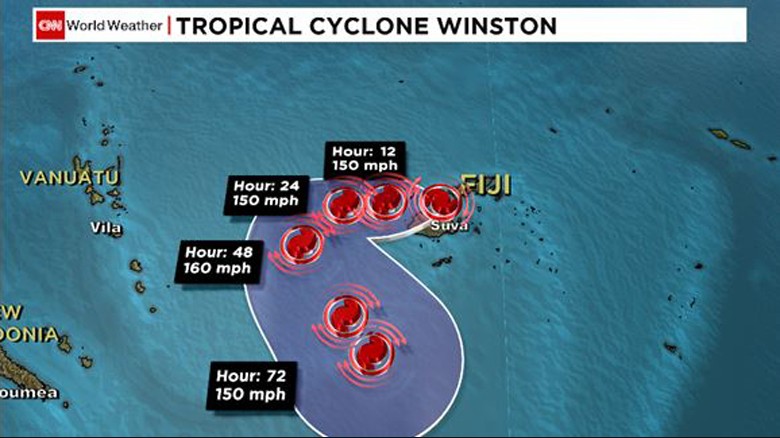I was reading about that yesterday, Joe. Here's the latest,Video and photos at link.
'Monster' Tropical Cyclone Winston reenergizes as it punishes FijiBy Kevin Conlon and Joshua Berlinger, CNN
Updated 8:48 PM ET, Sat February 20, 2016 | Video Source: CNN
(CNN)The most powerful storm on record in the Southern Hemisphere slammed straight into Fiji late Saturday, delivering the first crushing blows of a pounding that is expected to last for days on the tiny island nation.
The Joint Typhoon Warning Center estimated Tropical Cyclone Winston's winds reached 184 mph in the hours before it made landfall about 7 p.m. Saturday (2 a.m. ET).
"Winston was a monster of a cyclone," Fiji resident Nazeem Kasim told CNN. "I have not experienced anything like this before in my life, nor has my 60-year-old father."
The worst of the storm then went back out to sea, but only after wreaking havoc on the tourist hot spot with heavy flooding, rain and damaging winds. It could still end up hitting the South Pacific nation even more over the coming days.
The Fiji Broadcasting Corp. reported an elderly man was killed when a roof fell on him.
There are no other reports of other fatalities, and the full extent of the damage "is yet to be ascertained," according to the U.N. Office for the Coordination of Humanitarian Affairs (OCHA).
The government announced on Twitter that more than 750 evacuation centers had been activated.
Photos shared on social media with the hashtag #PrayForFiji showed an idyllic paradise beset by flooded streets, roofless houses and downed palm trees.
"It is likely that smaller villages across Fiji will have suffered the most, given their infrastructures would be too weak to withstand the power of a category 5 cyclone," said Suva resident Alice Clements, a spokeswoman for UNICEF in the Pacific.
"Families may have lost their homes and crops, therefore leaving them without shelter, food and a livelihood. There is also considerable risk for those that live by the sea or rivers as flash flooding and river flooding could occur due to heavy rains."
Fears of mudslides, coastal inundation
Fiji, an archipelago collectively about the size of New Jersey, lies in the South Pacific Ocean some 1,800 miles from Australia's east coast (by comparison, Hawaii is about 2,500 miles from Los Angeles). Most of the nation's 900,000 residents live on one of two main islands: Viti Levu or Vanua Levu.
Although not hit directly, the capital of Suva endured "damaging gale force winds, heavy rain and power outages." Clements, who was in Suva when the storm struck, said the city experienced "destructive, howling winds and the sound of rivets lifting from roofs a constant throughout the night."
The Red Cross said it was "fully prepared and on standby."
"We are well-organized and prepared," said Eseroma Ledua, operations manager at the Fiji Red Cross. "We have prepositioned relief items sufficient for 12,000 people in our headquarters in Suva and have mobilized over 300 staff and volunteers across our 14 branches nationwide.'
 This map showed a forecast track for the storm from early Sunday through early Wednesday Fiji time.
This map showed a forecast track for the storm from early Sunday through early Wednesday Fiji time.Widespread flash flooding and coastal inundation -- flooding in normally dry land -- "is likely as storm surges may push the sea inland several hundred meters," the Red Cross said.
Mudslides are a concern.
"This is a mountainous nation, and that means any heavy rainfall will filter down to the lower elevations -- meaning landslides, mudslides and flooding," said CNN meteorologist Derek Van Dam.
The western city of Nadi, on Fiji's main island, suffered minor wind damage but experienced extensive flooding, reported a television team from CNN affiliate TVNZ.
"You could hear things blowing around outside and even inside air got through the cracks and some things were blowing around my room," reporter Jessica Mutch said. Many trees were uprooted.
"You can really see that the infrastructure is not coping with the volume of water and things are getting blocked up," she said.
A nationwide curfew remained in effect and all flights were canceled.
Fiji PM: 'we must stick together'
Had it occurred in the Atlantic, Winston would have been a Category 5 hurricane, but because of hemispheric nomenclature, it's dubbed a cyclone. (In the Northwest Pacific, it would be a typhoon; all three
are the same weather phenomenon).
No matter what you call it, Fiji Prime Minister Frank Bainimarama had his own name for it: an "assault."
"As a nation, we are facing an ordeal of the most grievous kind," Bainimarama said. "We must stick together as a people and look after each other."
Bainimarama, who said that the government is "thoroughly prepared to deal with this crisis," declared a state of emergency that will be in effect for the next 30 days, according to the Fiji Times.
Record-setting winds
According to CNN meteorologist Allison Chinchar, while Winston weakened as it moved over land -- as these types of storms do -- it has since reintensified, and with the El Niño-warmed water serving as fuel, Winston's eye has reformed.
CNN meteorologist Michael Guy said Winston is expected to "keep strength as it continues on its path in open waters," but said "it will weaken Tuesday or Wednesday once it hits cooler waters and stronger shear."
Winston's 184 mph winds smashed the previous record for a Southern Hemisphere cyclone. According to Colorado State University hurricane expert Philip Klotzbach, both Cyclone Zoe, which battered the Solomon Islands in 2002, and Cyclone Monica, which walloped Australia in 2006, previously shared the record with their estimated winds of 178 mph.
The most powerful such storm on record in any hemisphere was Hurricane Patricia, which was estimated to have hit 200 mph before petering out over southwestern Mexico in October.
 CNN's Brandon Miller, Archith Seshadri and Tina Burnside contributed to this report.http://www.cnn.com/2016/02/20/us/tropical-cyclone-winston-fiji/
CNN's Brandon Miller, Archith Seshadri and Tina Burnside contributed to this report.http://www.cnn.com/2016/02/20/us/tropical-cyclone-winston-fiji/







